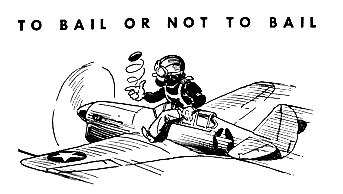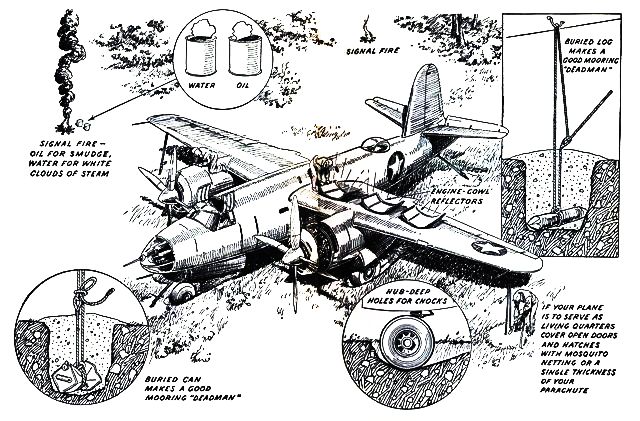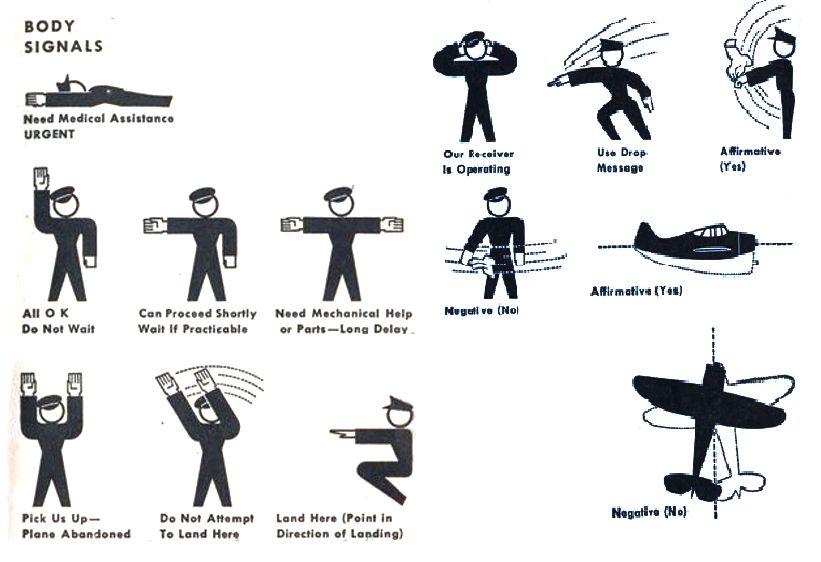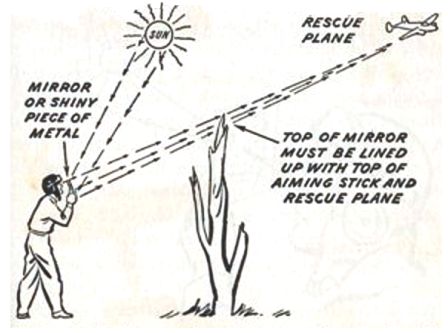
INTRODUCTION
No attempt has been made in this booklet to provide a complete and comprehensive guide to permanent bliss in the arctic, the desert, the jungle, or the ocean. Rather, it is a brief and concise resume of suggestions which will materially aid you in the event of an emergency landing. The suggestions presented should be coupled with imagination, ingenuity, common sense, and the natural instinct of self-preservation - the result being no reason why you can't beat any terrain or climate.
In a lengthy list of experiences of men who have faced the situation of being forced to make it alone in the Arctic, the desert, the jungle, or on an ocean, the necessity of maintaining a high morale and faith in the idea they will eventually get back is invariably stressed.
By following the few simple rules outlined on the following pages, the percentages will be all on your side.
A manual containing information for emergency procedures in the jungle, desert, Arctic and on the ocean is placed in parachute kits and in some other types of emergency kits.

If, however, it is necessary to bail out, you should attempt to: Tuck your maps and emergency rations inside your clothes. Make your way to the wrecked airplane if it is not too far away. Prepare some sort of signalling device for instant use.
General suggestions on preparedness: Wear, or carry with you, appropriate clothing for the trip. Wear shoes that you can walk home in.
In the case of crash landing, any landing that you can walk or swim away from is a good one. However, forced landings can be made in which little or no damage occurs to the airplane or crew. Those landings are the result of forethought, calm execution, and adherence to a few fundamental principles. The following suggestions may help you. Think them over, then plan in advance for the day when you may be confronted with the problem of putting your airplane down safely in the jungle, the desert, the Arctic or ditching it on the ocean. Stay clam. This is the primary role for any emergency.
Dump bombs in "safe," fuel, and other cargo that may endanger a successful landing, but when you dump be sure you are over open ground. Make sure that no loose equipment will be thrown around in the airplane by the imapct of the crash. Warn crew members of the impending crash.
Land "wheels up," unless you are positive that the terrain is such that a "wheels down" landing will not cause a nose-over. Don't fear a belly landing; it can be made with comparitively little damage. When landing in water, landing gear should always be retracted. Maintain flying speed until the airplane is on the ground or water. If you lose speed while high in the air, you may spin or stall in. Don't attempt turns near the ground or water; a stall may result. Land as nearly up wind as possible, never more than 90 degrees from the wind.
Landing on water involves considerable skill. The pilot should familiarize himself with ditching procedures before taking off on a log over-water flight. Use your flaps in land and water approaches so that the airplane will glide and land in the normal manner. Flaps will reduce your actual touching-down speed. If any power is availabble, use it to level off before striking. Just before the crash, turn off the ignition switch and the airplane master switch to avoid fire. If a solid obstruction is ahead, groundloop to kill some of your speed and to get the wing in a position where it will absorb most of the blow.
DON'T RUSH
THINK THINGS OUT, THEN ACT
Sleep and food are important, don't forego them in your eagerness to get out.
DON'T FEAR THE JUNGLE
A man can live for weeks in the jungle with safety if he will avoid panic and use his head.
GOOD FOOD AND GOOD WATER are fairly plentiful in the jungle if you know where to look for them.
MOST WILD ANIMALS won't bother you unless you bother them.
There is little more chance of being bitten by a POISONOUS SNAKE then there is of being struck by lightning back home. There are no poisonous snakes in Polynesia and in Malaysia they are rare.
With few exceptions JUNGLE NATIVES will be friendly if you make friendly approaches to them. DON'T TRY TO BULLY THEM. The exceptions include certain areas in Burma, western New Guinea where there are cannibals, and regions in Columbia, South America, where the Matalones live.
MALARIA is your worst enemy. Start immediately to take preventive doses of Quinine and Atabrine if you have a first aid kit.
If you were able to land or crash-land your plane in an open clearing, plan to stay with it for a few days. If you crash-landed in the trees, make a temporary camp near the wreckage. If you were following your normal flight course when you were forced down, your plane will be much easier for searchers to locate then you will be.
In a multi-place plane, good quarters can be set up inside the plane by covering the door and cockpit openings with mosquito netting or with your parachutes.
SIGNALS
If your plane is intact, and there is some chance that you may be able to fly it out,
your first job is to secure it by digging hub-deep holes for the landing wheels and
staking down the wings and tail.
If you have no staking kit, improvised stakes can be made by burying oil cans or two or three-foot
sections of tree branches.
Your second job is to attempt to establish radio contact and to set up signals.

Place bright-colored or reflecting objects on the wings and around the plane.
Cowl panels removed from the engine nacelles and placed upside-down with their unpainted
surfaces pointing up form good reflectors.
Line them up side-by-side on the wings where they can reflect the sun and will be readily visible
from the air.
Lay several fires within a few hundred feet of the plane, so they can be lighted when a rescue plane
is sighted during the day or heard at night.
Place a small can of engine oil and a can of water near one of the fires - engine oil thrown on
a fire will produce black smoke, water will send up billows of steam.
Do everything that you can to make the plane stand out against its background.
Remember, your plane is a green-brown that by design is a good match for the ground.
Objects whose colors contrast with that of the trees and grass, such as orange life-preserver
cushions, will stand out against the background if they are put out on the fuselage and wings
where they can be seen.

Once you have sighted a rescue plane and attracted the attention of the pilot, the body signals
on this page can be used to transmit messages.

When the sun is shining, a mirror or any piece of shiny metal - your rear-vision mirror, a food tin,
or a piece of metal from the plane - can be used as one of the best of all signalling devices.
However, the mirror must be accurately aimed if the reflection of the sun in the mirror is to be
seen by the pilot of a passing plane.
One of the simplest ways to aim a mirror is to use an aiming stake as shown.
Any piece of wood four or five feet long can serve as the stake, or one of you party can stand
in position.
Hold the mirror so you can sight along its upper edge.
Change you position until the top end of the stick and the plane line up,
 then adjust the angle of the mirror until the beam of light reflected by the mirror
hits the top of the stick.
If stick and plane are then kept in the sighting line, the reflection will be visible from the plane.
then adjust the angle of the mirror until the beam of light reflected by the mirror
hits the top of the stick.
If stick and plane are then kept in the sighting line, the reflection will be visible from the plane.
Some emergency kits are now fitted with a special signalling mirror, which is a double-faced
mirror (i.e. mirrored on both sides) and provided with a sighting or aiming hole.
If you have one of these, use it.
Divide the general duties among your crew.
It will help to prevent fear and panic.
Post a guard every night.
If you are reasonably sure that you are not within, or dangerously near, enemy-held territory,
the guard should keep a signal fire going continuously.
This will conserve your signal pistol ammunition or flares for the more important job of
signalling a rescue plane when it is actually heard or sighted.
Fix your location by compass, octant, or the stars.
Make scouting trips out from the plane in search of streams, making sure to mark the trail
in the form of knife cuts on trees, bent branches, arrows, or bits of paper or cloth.
Never go any distance from the plane without laying some sort of trail that can be followed back.
IT IS VERY EASY TO ROAM IN CIRCLES IN THICK FOREST OR JUNGLE.
WATER
If you find a stream, make careful note of its direction and position from your camp.
It will not only provide you with water for drinking, washing, and cooking, but it may lead you
to civilization when you decide to give up hope of rescue and start to walk your way out.
If you can't locate a stream for drinking water, dig a hole in the lowest depression near your camp.
If you don't strike water down three or four feet, try another spot.
Unless you are on high ground, water should be located in a few trys.
Animal trails will eventually lead you to water if you are careful not to get lost in the maze
of intersecting paths.
ALL ANIMALS, WITH FEW EXCEPTIONS, TRAVEL TOWARDS WATER AT DAWN AND DUSK.
WARNING: All water for drinking must be purified either by boiling for three minutes or
by treatment with Halazone tablets (or iodine if Halazone tablets are not available).
PARACHUTE

Save your parachute, or as much of it as you can.
The shrouds cut loose can be braided into a strong rope and the canopy can be cut and folded
to form a good tent.
A single parachute shroud line has a minimum breaking strength of several hundred pounds,
so a double strand will be strong enough to carry your weight with plenty of strength to spare.
However, shroud line will chafe easily when run over rock or tree bark.
CLOTHING
If you were able to land your plane, check your equipment carefully before leaving for your
trek back to civilization.
In jungle travel it is important to keep as dry as possible.
If you have them, include extra shirt, pants, underwear and socks in your kit in spite of the
weight the add.
The jungle's high temperatures and high relative humidity will make you sweat freely and any
rapid cooling of your sweat-wet body should be avoided.
Chilling due to the rapid evaporation of the sweat reduces body resistance and can be
the cause of pneumonia, bronchitis, stomach cramps, and skin infections like fungus and prickly heat.
BEFORE LEAVING YOUR PLANE BURN ALL PAPERS, TECHNICAL ORDERS, AND TRIP DATA THAT MIGHT BE SECRET,
RESTRICTED, CONFIDENTIAL, OR CLASSIFIED.
SECRET INSTRUMENTS SHOULD BE SMASHED AND THE PARTS BURIED.
IF YOU ARE IN OR NEAR ENEMY TERRITORY, BURN THE PLANE.
PART THE JUNGLE, DON'T TRY TO PUSH THROUGH IT.
Travel in the jungle forests is slow.
Try to follow a stream downstream, and try as far as possible to stick to natural trails,
or native trails.
Don't try to break your way through.
Blundering ahead only leads to bangs on the head and thorn scratches on your face.
You will get through faster if you watch your step and pick your way.
Keep your head up and your chin in.
If you can't find a stream or native trail, follow the swampy hollows which generally run in chains
and eventually join a stream.
In hilly country, the ridges are easier to follow than the valleys, but precipices may make long
detours necessary.
In elephant country, follow the elephant trails.
Elephants do not wander aimlessly.
If a track shows frequent use, follow it.
Elephants never go where they are likely to fall or get bogged.
Elephant trails are 3 or 4 feet wide, other game trails are a foot to 18 inches wide.
WILD ANIMALS
In just about ninety-nine cases out of a hundred, jungle animals will be just as frightened of you
as you are of them.
They will hear you long before you can see them and in most cases they will do their best to keep
out of your path.
If you are traveling alone and want some form of protection at night in a particular area where
you feel large animals are present, build a fire and pile on bamboos.
They will go off like gunshots and make enough noise to scare away any animals that may be nearby.
In an emergency, a shot from your signal pistol will scare off an angry elephant or a tiger.
WARNING:
One of your worst enemies in the jungle is the mosquito.
Never go to sleep without some sort of protection - regular netting if you have it or your parachute.
Don't sleep on the bare ground.
Protect yourself from mosquitoes and all bugs.
NATURAL FOOD
Natural food is plentiful in most jungles if you know where to look for it and are able to
distinguish between the edible and the poisonous.
There are only three general rules beyond definite recognition -
EAT NOTHING THAT HAS A BITTER TASTE UNLESS YOU ARE SURE WHAT IT IS.
AVOID ALL PLANTS THAT HAVE A MILKEY SAP.
ANYTHING THAT YOU SEE MONKEYS EAT, YOU CAN EAT.
JUNGLE HEALTH

Three things are absolutely necessary to your health in the jungle - periodic doses of Quinine or
Atabrine, a Quinine substitute, the use of some sort of mosquito protection, and daily doses of
salt or salt tablets to replace the salt removed from the body by excessive sweating.
JUNGLE NATIVES
With the exception of those in New Guinea and in parts of Assam, There are few dangerous jungle
natives.
When you encounter natives, try to appear confident but not aggressive.
Stay away from the women.
All natives are superstitious and suspicious.
Through generations they have learned to trust no one.
You can only win their confidence by appearing open-handed.
String tricks - the cat's cradles and spider webs that you did when you were a kid - are an almost
universal pastime with jungle natives all over the world.
If you remember any of them, pick up a piece of pliable vine and demonstrate them to natives
you meet.
In most cases it will serve as an immediate bond between you and them.
If you can't do a string trick, go through the motions to arouse their curiosity.
Be particularly careful of your treatment of natives if you are in or near enemy territory.
If they want to, they can help you get back to your lines.
Don't try to use terrorist methods to get them to work for you or conceal you.
Jungle natives move about a great deal, but if they are not threatened or abused they will seldom rush
news of your presence to the enemy.
Eat native food only when it has been well and freshly cooked and be sure all water offered you by
natives has been boiled.
Under no conditions sleep in or near native camps or bathe in nearby streams.
Avoid close contact with any native.
Don't go around barefoot.



OFFICE OF FLYING SAFETY
SAFETY EDUCATION DIVISION

Adapted for the internet from an original USAAF Survival Guide used in the CBI Theater.
Special thanks to S/Sgt. Nick Sanchez, USAAF and Past Commander, Heart of the Hills Basha,
China-Burma-India Veterans Association, for providing the booklet on which this page is based.
Copyright © 2004 Carl Warren Weidenburner
TOP OF PAGE ABOUT THIS PAGE CLOSE THIS WINDOW